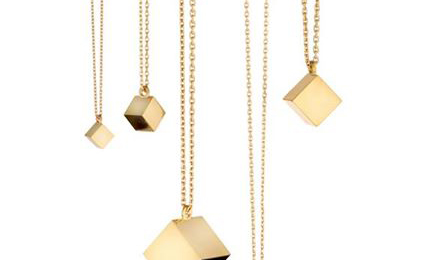GoldVolks at abc – art berlin contemporary
Event Type:
Exhibition
Location:
abc art berlin contemporary STATION-BERLIN, Luckenwalder Strasse 4-6, 10963 Berlin
Date:
September 17, 2015 - September 20, 2015

KÖNIG BERLIN is pleased to present a new work by Alicja Kwade produced in collaboration with the goldsmith Georg Hornemann. Titled GoldVolks, it consists of ninety-seven gold cubes on chains and will be on display at this year’s art berlin contemporary.
Kwade examines the genesis and application of structures of reality that are based on social conventions—cultural patterns, tacit agreements, and codes—in sculptures, installations, and photographs that combine aesthetic appeal with a challenge to our habitual ways of looking at things.
GoldVolks grew out of Kwade’s interest in the national gold reserves kept by most countries’ central banks. Until 1973, they served as backing for currencies (a system known as the gold standard). Now gold reserves are maintained to hedge against fluctuating US dollar exchange rates and provide for periods of crisis. Since gold is universally accepted as a means of payment, large gold holdings suggest a country’s high degree of independence. Ninety-seven countries officially quantify their gold reserves; statistics are available from the World Gold Council. In 2015, Germany is second on the list with reserves of 3384.2 tons; the United States holds the top spot, with 8,133.5 tons, while Lebanon, for instance, is 19th, with reserves of 286.8 tons.
Kwade took the ninety-seven listed gold reserve holdings and divided them by each country’s official population (CIA World Fact Book). The goldsmith Georg Hornemann then cast these per-capita amounts of fine gold into the simplest possible geometric shape, a cube; the objects are presented like pendants on gold chains. Kwade’s cubes, in other words, represent the gold hypothetically owned by each citizen—what each of us would receive if our countries’ reserves were distributed to the citizenry. In this ranking of per-capita reserves, Germany is third, while the United States fares even worse, slipping down to thirteenth place; the Lebanese cube, on the other hand, is unusually large, second only to the Swiss.
Hung one next to the other in a glass case, the gold pendants illustrate a measure of the global distribution of wealth, allowing for a visual and tactile experience of an abstract numerical ranking. During art berlin contemporary, Kwade will ask visitors to wear a chain, perhaps their own country’s. Chains of countries that no one is willing to represent will remain inside the case. Wearing one of the gold pendants may inspire a feeling of sharing in a country’s wealth, even if its prosperity is not necessarily enjoyed by all its residents.